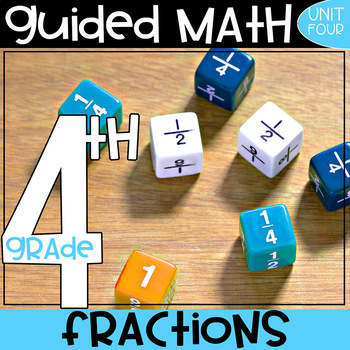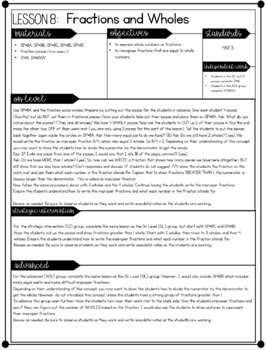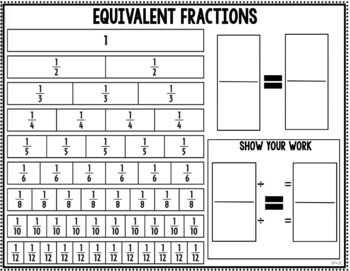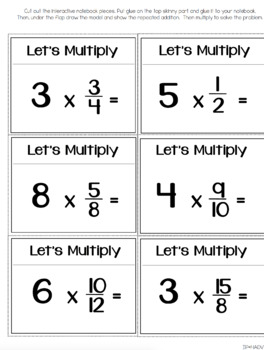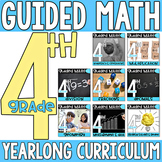4th Grade Guided Math - Fractions
Simply Skilled in Second
35.4k Followers
Grade Levels
4th
Subjects
Resource Type
Standards
CCSS4.MD.A.2
CCSS4.NF.A.1
CCSS4.NF.A.2
CCSS4.NF.B.3
CCSS4.NF.B.3a
Formats Included
- PDF
Pages
233 pages
Simply Skilled in Second
35.4k Followers
What educators are saying
A great resource for students to review skills covered in class. This resource can be used as individual review or collaborative review in small groups.
Also included in
- Fourth Grade Guided Math: This 4th grade Guided Math Yearlong Curriculum Bundle incorporates EVERYTHING you will need to easily and effectively implement Guided Math in your 4th Grade classroom. Implementing Guided Math in fourth grade has never been easier! Check out this Guided Math curriculum bunPrice $96.00Original Price $120.00Save $24.00
Description
Fourth Grade Guided Math: Fractions and Fraction Lessons: This is the fourth unit in my 4th Grade Guided Math curriculum. This unit focuses on FRACTIONS and includes EVERYTHING you will need to quickly and efficiently implement Guided Math in your 4th Grade classroom.
It is completely aligned to the Common Core State Standards.
This 4th Grade Guided Math resource includes 15 DIFFERENTIATED lessons on the following concepts:
* Intro to Fractions
* fractions on a number line
* equivalent fractions
* comparing fractions
* comparing fractions using benchmarks
* ordering fractions
* simplifying fractions
* fractions and wholes
* improper Fractions and Mixed Numbers
* adding fractions
* subtracting fractions
* adding mixed numbers
* subtracting mixed numbers
* multiplying fractions by whole numbers
* problem solving using fractions
This 4th Grade Guided Math Fractions Resource includes:
☞ Fully Detailed and Differentiated Lesson Plans for Small Group Instruction
☞ Information Guide on HOW TO effectively implement Guided
Math in your classroom (images and text instructions)
☞ Independent Practice Printables / Interactive Notebook activities
aligned to each small group instruction lesson
☞ Guided Practice Workmats for EACH lesson to help guide your
small group instruction
☞ 20 Word Problems for Math Journals
☞ 15 Math Stations - 5 SPIN-ITS Math Stations, 5 Roll-Its Math Stations, and 5 Solve-Its Math Stations
☞ Pre and Post Assessments on numeracy and operations
☞ Guided Math Organization tools - Guided Math Binder Cover,
Binder Spines, Binder dividers lesson plan templates, anecdotal
notes template, weekly lesson plan template, math journal labels,
math station labels, large poster-sized iChart (print at office
supply store), math station recording sheet, and fact fluency
station labels
☞ Links to resources and tools that I use during my Guided Math
instruction
This Guided Math Division Resource is JAM-PACKED with EVERYTHING you need to quickly and efficiently implement Guided Math in your 4th Grade Classroom!
If you are interested in this resource, please check out the BUNDLE to save a BUNDLE!
It is completely aligned to the Common Core State Standards.
This 4th Grade Guided Math resource includes 15 DIFFERENTIATED lessons on the following concepts:
* Intro to Fractions
* fractions on a number line
* equivalent fractions
* comparing fractions
* comparing fractions using benchmarks
* ordering fractions
* simplifying fractions
* fractions and wholes
* improper Fractions and Mixed Numbers
* adding fractions
* subtracting fractions
* adding mixed numbers
* subtracting mixed numbers
* multiplying fractions by whole numbers
* problem solving using fractions
This 4th Grade Guided Math Fractions Resource includes:
☞ Fully Detailed and Differentiated Lesson Plans for Small Group Instruction
☞ Information Guide on HOW TO effectively implement Guided
Math in your classroom (images and text instructions)
☞ Independent Practice Printables / Interactive Notebook activities
aligned to each small group instruction lesson
☞ Guided Practice Workmats for EACH lesson to help guide your
small group instruction
☞ 20 Word Problems for Math Journals
☞ 15 Math Stations - 5 SPIN-ITS Math Stations, 5 Roll-Its Math Stations, and 5 Solve-Its Math Stations
☞ Pre and Post Assessments on numeracy and operations
☞ Guided Math Organization tools - Guided Math Binder Cover,
Binder Spines, Binder dividers lesson plan templates, anecdotal
notes template, weekly lesson plan template, math journal labels,
math station labels, large poster-sized iChart (print at office
supply store), math station recording sheet, and fact fluency
station labels
☞ Links to resources and tools that I use during my Guided Math
instruction
This Guided Math Division Resource is JAM-PACKED with EVERYTHING you need to quickly and efficiently implement Guided Math in your 4th Grade Classroom!
If you are interested in this resource, please check out the BUNDLE to save a BUNDLE!
Total Pages
233 pages
Answer Key
N/A
Teaching Duration
3 Weeks
Report this resource to TPT
Reported resources will be reviewed by our team. Report this resource to let us know if this resource violates TPT’s content guidelines.
Standards
to see state-specific standards (only available in the US).
CCSS4.MD.A.2
Use the four operations to solve word problems involving distances, intervals of time, liquid volumes, masses of objects, and money, including problems involving simple fractions or decimals, and problems that require expressing measurements given in a larger unit in terms of a smaller unit. Represent measurement quantities using diagrams such as number line diagrams that feature a measurement scale.
CCSS4.NF.A.1
Explain why a fraction 𝘢/𝘣 is equivalent to a fraction (𝘯 × 𝘢)/(𝘯 × 𝘣) by using visual fraction models, with attention to how the number and size of the parts differ even though the two fractions themselves are the same size. Use this principle to recognize and generate equivalent fractions.
CCSS4.NF.A.2
Compare two fractions with different numerators and different denominators, e.g., by creating common denominators or numerators, or by comparing to a benchmark fraction such as 1/2. Recognize that comparisons are valid only when the two fractions refer to the same whole. Record the results of comparisons with symbols >, =, or <, and justify the conclusions, e.g., by using a visual fraction model.
CCSS4.NF.B.3
Understand a fraction 𝘢/𝘣 with 𝘢 > 1 as a sum of fractions 1/𝘣.
CCSS4.NF.B.3a
Understand addition and subtraction of fractions as joining and separating parts referring to the same whole.

